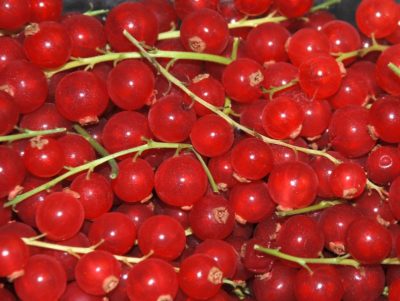
Red currant
Red currants originate from western Europe, and that is also where most red currants are produced.
Red currants are usually eaten fresh. The juicy bright red fruits have a rather sour taste. Tea made of the leaves of red currant have medicinal properties. It can ease symptoms of gout and rheumatism and it is also used in compresses on wounds. As a gargling solution the tea of red currant leaves is used to treat mouth infections.
Red currants belong to the same species as white currants (Ribes rubrum). The difference is just a variation in color.
Names
Scientific
Ribes rubrum
English
Red currant
Redcurrant
Dutch
Aalbes
Rode bes
Spanish
Grosella roja
Grosellero
French
Groseille
Groseille rouge
German
Garten-Johannisbeere
Rote Johannisbeere
Taxonomy
Order
Saxifragales
Family
Grossulariaceae
Genus
Ribes
Species
Ribes rubrum (Red currant)
Basic information and facts
Origin:
Red currants originate from western Europe
Distribution:
They are mainly grown in western Europe, including Netherlands, Belgium, France, England, Germany, Poland, and the Northern parts of Italy, Spain and Portugal.
Evergreen or deciduous:
Red currants are deciduous plants.
Flowers:
Flowers are yellowish green in color.
Leaves:
The five-lobed leaves are used to make medicinal teas.
Fruits:
The flowers mature into bright red translucent berries. Each berry is about 8 to 12 mm in diameter. Usually there are about 10 berries on a raceme.
Climate and weather:
Red currants grow in a temperate climate.
Pollination:
The flowers are hermaphroditic and self-pollinating.
Height:
Redcurrant grows as a shrub which is usually 1 to 1.5 meter tall.
Type of soil:
Red currants can grow in most types of soil.
Spacing
About 1.2 meters apart in the row and 1.5 meters between rows.
Propagation:
Redcurrants can be propagated by planting foot long pieces of mature wood about 3 to 4 inches deep in a pot of compost. Roots will develop from the wood under the soil giving you a new redcurrant bush.
Also layering of red currant is possible. A low-growing cane is carefully twisted to the ground. Then weigh it down with a brick or piece of metal to hold it in place,and cover it with soil. Roots will grow from the stem resulting in a new redcurrant plant.
Insect pests:
Diseases:
Fruit development:
The bright red fruits are available from mid to late summer in western Europe.
Harvesting:
Red currants are hand picked when the fruits are ripe (bright red).
Uses:
Red currants are usually eaten fresh or mixed in fruit salads. Because of their bright re color they can be used as garnish.
Proverbs and Quotes
- Swinging clusters of red, the hedges are full of them, red-currant red, a graceful ornament or a merry smile. (Denise Levertov)
- Who knows more red currant quotes, or a red currant proverb?
Did you know that?
- Red currants belong to the same plant species as white currants (Ribes rubrum). The difference is just a variation in color.
- Tea made from dried redcurrant leaves can ease symptoms of gout and rheumatism. It is also used in compresses on wounds. As a gargling solution the teas is used to treat mouth infections.
Recipes
Red currant gin
Ingredients:
60 ml gin, 90 ml syrup, 10 ml lemon juice, 15 ml lychee liqueur, 200 g fresh red currants
Instructions:
Strain the fruits through a sieve. Put the juice in a cocktail shaker filled with ice cubes and add gin, syrup, lemon juice and lychee liqueur. Shake, strain into a glass and serve.
Crop categories
Cool temperate crops
Fruits
Medicinal plants
Minor crops
Temperate crops
Pictures

Red currant

Red currant

One thought on “Red currant”
What is the variety that they grow in Finland ?. They don’t need any special pruning and they have a massive yield that doesn’t reduce with age. I have seen this myself in many different parts of Finland over the years